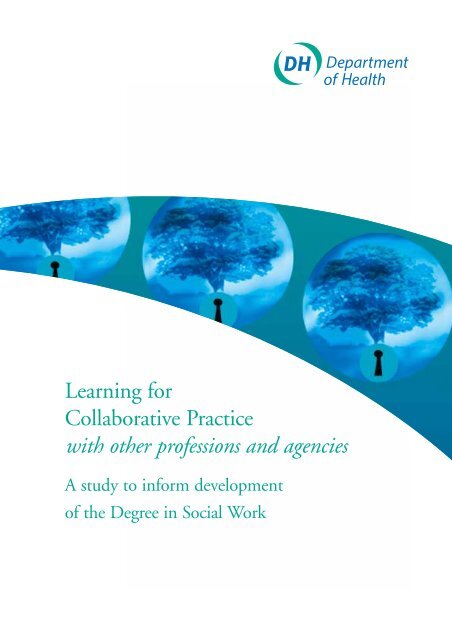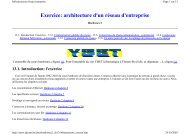Learning for Collaborative Practice with other professions and ... - Free
Learning for Collaborative Practice with other professions and ... - Free
Learning for Collaborative Practice with other professions and ... - Free
- No tags were found...
You also want an ePaper? Increase the reach of your titles
YUMPU automatically turns print PDFs into web optimized ePapers that Google loves.
<strong>Learning</strong> <strong>for</strong> <strong>Collaborative</strong> <strong>Practice</strong><strong>with</strong> <strong>other</strong> <strong>professions</strong> <strong>and</strong> agenciesA study to in<strong>for</strong>m developmentof the Degree in Social WorkCommissioned by the Department of HealthSummary ReportDr Colin WhittingtonIndependent Consultant in <strong>Learning</strong> <strong>and</strong> Developmentwww.colinwhittington.com
Contents1. Reasons <strong>for</strong> the study <strong>and</strong> its relevance to priorities in policy <strong>and</strong> practice 32. The subject 33. Aim <strong>and</strong> purpose 44. Method <strong>and</strong> response 45. Three main sets of findings <strong>and</strong> their uses 46. Factors that affect the development of learning opportunities 57. In<strong>for</strong>mation <strong>and</strong> advice on teaching, learning, content <strong>and</strong> assessment 68. In<strong>for</strong>mation sought <strong>and</strong> offered by providers on work in progress 99. Using the findings in development of the Degree 1010. Twelve pointers to review <strong>and</strong> action 11References 131
Summary Report1. Reasons <strong>for</strong> the study <strong>and</strong> its relevance to prioritiesin policy <strong>and</strong> practice1.1 <strong>Learning</strong> to work collaboratively <strong>with</strong> <strong>other</strong> professionals <strong>and</strong> agencies is a clear expectation of socialworkers in the ‘prescribed curriculum’ <strong>for</strong> the new Social Work Degree (DoH 2002). The reasonsare plain:●●●Service users want social workers who can collaborate effectively <strong>with</strong> <strong>other</strong>s to obtain <strong>and</strong>provide services (Audit Commission 2002)Collaboration is central in implementing strategies <strong>for</strong> effective care <strong>and</strong> protection ofchildren <strong>and</strong> of vulnerable adults as underlined, respectively, by the recent report of theVictoria Climbié Inquiry (Laming 2003) <strong>and</strong> the earlier ‘No Secrets’ policies (DoH 2000)Effective collaboration between staff at the ‘front-line’ is also a crucial ingredient in deliveringthe Government’s broader goals of partnership between services (Whittington 2003).1.2 Experience is growing of what is involved in learning <strong>for</strong> collaborative practice. This experiencepromises valuable in<strong>for</strong>mation <strong>for</strong> Social Work Degree providers <strong>and</strong> <strong>other</strong>s developing learningopportunities but has not been systematically researched in UK social work programmes <strong>for</strong> a decade(Whittington 1992; Whittington et al 1994). The providers of Diploma in Social Work programmes(DipSW) represented an untapped source of directly transferable experience in this area of learning <strong>and</strong>were there<strong>for</strong>e chosen as the focus of the study.1.3 The study is reported in two documents:●●The Summary Report here, outlines the study, summarises the main findings <strong>and</strong> describes waysof using them in developing the Social Work DegreeA separate Research Report gives details of the conception <strong>and</strong> design of the study <strong>and</strong> reports thefindings in full (available on request from Beshlie.Squires@doh.gsi.gov.uk).2. The subject2.1 The subject was ‘learning <strong>for</strong> collaborative practice (LfCP) <strong>with</strong> <strong>other</strong> <strong>professions</strong> <strong>and</strong> agencies’.This complements, <strong>and</strong> distinguishes the study from, a second key area of collaborative practice, that is,<strong>with</strong> service users <strong>and</strong> carers.2.2 The expression ‘learning <strong>for</strong> collaborative practice’ is used to encompass a variety of terms such as‘interprofessional learning’ (IPL), ‘multi-disciplinary learning’ <strong>and</strong> ‘inter-agency’ learning, by describingtheir common objective.3
<strong>Learning</strong> <strong>for</strong> <strong>Collaborative</strong> <strong>Practice</strong> <strong>with</strong> <strong>other</strong> <strong>professions</strong> <strong>and</strong> agencies3. Aim <strong>and</strong> purpose3.1 The aim was a ‘first stage’ inquiry to gather <strong>and</strong> analyse in<strong>for</strong>mation on experience <strong>and</strong> initiatives amongDipSW providers in their development of learning <strong>for</strong> collaborative practice <strong>with</strong> <strong>other</strong> <strong>professions</strong> <strong>and</strong>agencies.3.2 The purpose was to generate findings to in<strong>for</strong>m a ‘second stage’ of dialogue <strong>and</strong> development to supportthe new Degree, <strong>for</strong> example, via the Department of Health ‘Social Work Steps Forward’ RegionalWorkshops (May/June 2003), where the findings were used.4. Method <strong>and</strong> response4.1 The study sought the co-operation of the 78 DipSW programme providers in Engl<strong>and</strong> in an emailattachedquestionnaire survey (July/August 2002) to identify work in progress <strong>and</strong> to learn from theexperience gained.4.2 The questionnaire was actively followed-up, gaining a 50% response rate (n=39). All the main categoriesof programme provider, route, type <strong>and</strong> region were represented.4.3 Interviews were held (September/October 2002) <strong>with</strong> representatives of a sub-sample of nine DipSWprogramme providers. The interviews sought more detail of the experience that providers would pass tofellow social work programmes preparing <strong>for</strong> the new Degree.4.4 The study was primarily qualitative <strong>and</strong> exploratory. It focused on respondents’ experience, seeking notstatistical significance in the findings but an underst<strong>and</strong>ing of the issues that were important indeveloping learning <strong>for</strong> collaborative practice.5. Three main sets of findings <strong>and</strong> their uses5.1 The study gained three broad sets of findings:1. Factors that affect the development of learning opportunities (Section 6).2. In<strong>for</strong>mation <strong>and</strong> advice on teaching, learning, content <strong>and</strong> assessment (Section 7).3. In<strong>for</strong>mation sought <strong>and</strong> offered by providers on work in progress (Section 8).5.2 The findings are summarised below <strong>and</strong> followed by sections on:Using the findings in development of the Social Work Degree (Sections 9 <strong>and</strong> 10)The uses include:●●●●in<strong>for</strong>ming course practices <strong>and</strong> promoting dialogue <strong>and</strong> networkingraising questions on the profile <strong>and</strong> coverage of learning initiativesposing questions about the knowledge base available to teachers <strong>and</strong> students, <strong>and</strong> aboutprofessional identitygiving 12 pointers to review <strong>and</strong> action planning in developing the Social Work Degree4
<strong>Learning</strong> <strong>for</strong> <strong>Collaborative</strong> <strong>Practice</strong> <strong>with</strong> <strong>other</strong> <strong>professions</strong> <strong>and</strong> agencies6. Factors that affect the development of learningopportunities6.1 Respondents to the questionnaire were asked what factors, respectively, assisted <strong>and</strong> hindered thedevelopment of opportunities <strong>for</strong> learning to practice collaboratively <strong>with</strong> <strong>other</strong> <strong>professions</strong> <strong>and</strong>agencies. It was reasoned that in<strong>for</strong>mation on these two dimensions would help to guide constructiveaction by Degree providers <strong>and</strong> <strong>other</strong>s.6.2 All respondents recounted both factors that helped <strong>and</strong> hindered. While none had found developmentproblem-free, all could identify factors that had assisted them. Factors that hindered or assisted oftenrepresented two sides of the same coin. Put simply, it is an asset if you have the necessary placements<strong>and</strong> a hindrance if you do not. However, developing learning <strong>for</strong> collaborative practice does not reston a single factor. For example, some respondents reported that even where sought-after placementswere in short supply, <strong>other</strong> factors, like the creativity of practice teachers offered a compensating asset.Nine sets of factors affected the development of opportunities <strong>for</strong> learning <strong>for</strong> collaborativepractice:i) placements: the availability of suitable placementsii)iii)iv)practice teachers: the availability, skills <strong>and</strong> creativity of practice teachersfaculty teachers: the commitment <strong>and</strong> expertise of faculty <strong>and</strong> visiting teacherscourses, curricula <strong>and</strong> students: the structure of courses, the level of curriculum development,<strong>and</strong> the nature of learning opportunities <strong>and</strong> student attitudes to themv) regulations <strong>and</strong> requirements: the degree to which expectations of collaborative practice areclear in regulations <strong>and</strong> assessment requirementsvi)vii)viii)ix)university structure <strong>and</strong> climate: the level of multi-disciplinary integration <strong>and</strong> co-operationin university structures <strong>and</strong> climatelocal agencies <strong>and</strong> professionals: the quality of relations <strong>with</strong> local agencies <strong>and</strong> <strong>professions</strong><strong>and</strong> their attitudes to social work <strong>and</strong> collaborative practicetime <strong>and</strong> budgets: the availability of time <strong>and</strong> budgets to support development of thecurriculum, key relationships <strong>and</strong> structures, <strong>and</strong> learning opportunitiesconceptions of collaboration <strong>and</strong> identity, <strong>and</strong> related values: the conceptions ofcollaborative practice <strong>and</strong> of the professional or interprofessional identity the course seeksto develop6.3 Examples of factors that assisted development of learning opportunities:Some of the more frequently cited factors that assisted were:●●●active curriculum development especially where this capitalises on or establishes links <strong>with</strong> <strong>other</strong>disciplines <strong>and</strong> coursesaccess to learning <strong>for</strong> collaborative practice in multi-disciplinary settings or via practice teachersable to creatively access alternative learning opportunitiesfaculty <strong>and</strong> visiting teachers who are well-in<strong>for</strong>med on collaborative practice issues <strong>and</strong>committed to interprofessional development5
<strong>Learning</strong> <strong>for</strong> <strong>Collaborative</strong> <strong>Practice</strong> <strong>with</strong> <strong>other</strong> <strong>professions</strong> <strong>and</strong> agencies●●●●take particular care when setting-up both new multi-disciplinary placements <strong>and</strong> ‘alternative’ones since both may involve fewer givens than usualactively brief <strong>and</strong> de-brief all parties <strong>and</strong> include non-social worker supervisorsplan <strong>and</strong> resource realistically <strong>for</strong> the time <strong>and</strong> support that university <strong>and</strong> agency staff willrequireremember that you are culture-changing, which takes time <strong>and</strong> patience7.2 Teaching <strong>and</strong> learning <strong>for</strong> collaborative practice7.2.1 Interviewees were asked about their materials <strong>and</strong> sources on methods of teaching <strong>and</strong> learning.To summarise:●the sample programmes appeared to use two models of learning, <strong>with</strong> different degrees ofemphasis:– a content model seeks to locate <strong>and</strong> teach a knowledge base of what collaborative practice is<strong>and</strong> how to do it;– a process model casts the teacher as facilitator working <strong>with</strong> the learner’s capacity to reflect<strong>and</strong> develop interactively <strong>with</strong> <strong>other</strong>s●●the interviews did not locate a readily available <strong>and</strong> unified knowledge base or accessible set ofmodels <strong>for</strong> teaching <strong>and</strong> learninginstead, respondents emphasised:– transferability of learning methods from familiar domains in social work, including practiceteaching <strong>and</strong> tutorial methods– using the particular expertise <strong>and</strong> interests of the staff team– the application of sources from adult learning, reflective learning <strong>and</strong> organisationallearning supported by library sources in social work teaching <strong>and</strong> adjacent fields– locally-devised models <strong>for</strong> joint <strong>and</strong> interactive learning <strong>and</strong> the application, <strong>for</strong> example,of problem-based learning– contact <strong>and</strong> exchange <strong>with</strong> <strong>other</strong> social work programmes7.3 Course content <strong>for</strong> learning <strong>for</strong> collaborative practice7.3.1 Interviewees were asked about materials <strong>and</strong> sources they used in helping students to workcollaboratively. In summary:●●●●great store was placed upon human sources, <strong>with</strong> service users the most commonly <strong>and</strong>enthusiastically cited sourcethe sample programmes also drew directly on the knowledge <strong>and</strong> experience of social workcourse teachers <strong>and</strong> students <strong>and</strong> on students <strong>and</strong> teachers from <strong>other</strong> disciplines <strong>and</strong><strong>professions</strong>examples were given of ‘home grown’ teaching content including modules on working inorganisations <strong>and</strong> across professional boundaries, <strong>and</strong> of the transfer of ideas from outside careservicesthe interviews did not locate a readily accessible <strong>for</strong>mal knowledge base or sets of models <strong>for</strong>collaborative practice to complement the human <strong>and</strong> home grown sources7
<strong>Learning</strong> <strong>for</strong> <strong>Collaborative</strong> <strong>Practice</strong> <strong>with</strong> <strong>other</strong> <strong>professions</strong> <strong>and</strong> agencies●while there was clear evidence of <strong>for</strong>mal (library) sources in course h<strong>and</strong>books, someinterviewees reported a lack of focused materials on how to work collaboratively <strong>and</strong> gaps in theevidence of its effectiveness.7.4 Responding to challenges in practice assessment7.4.1 Interviewees were asked what were the main challenges in assessment <strong>for</strong> collaborative practice <strong>and</strong>how they would respond. Many of the challenges facing assessment in this area are ones that may beexpected in any newly-emerging field of learning <strong>and</strong> they are given an added layer by the multiprofessionalelement.7.4.2 The multi-professional dimension poses questions about: the nature of collaborative competence <strong>and</strong> howit may be achieved <strong>and</strong> demonstrated; the nature of the professional or interprofessional identity to bedeveloped; <strong>and</strong> the participation in assessment of social work <strong>and</strong> non-social work professionals.7.4.3 Related to the above, there are uncertainties in assessment methodology concerning: requirements <strong>and</strong>criteria; expected evidence; the st<strong>and</strong>ard of per<strong>for</strong>mance to be achieved; <strong>and</strong> an assessment language that isunderstood by different <strong>professions</strong>.7.4.4 These challenges are compounded where there are shortages of suitable practice learning opportunities<strong>and</strong> practice teachers, <strong>and</strong> where dual awards involve joint assessment <strong>and</strong> two sets of requirements.7.4.5 Responses implied that assessment <strong>for</strong> collaborative practice lacks an accessible, developed conceptualbase <strong>and</strong> methodology.7.4.6 However, all interviewees cited practical measures to respond to the challenges in practiceassessment <strong>and</strong> they included the following:Requirements, criteria <strong>and</strong> evidence●●●●●●clarify expectations of collaborative competence <strong>and</strong> the profile of the integrated orinterprofessional worker that training seeks to developbrief <strong>and</strong> debrief all parties using locally produced guidance <strong>and</strong> briefing materials onrequirements, criteria <strong>and</strong> evidencecall also <strong>for</strong> national joint work on guidance <strong>and</strong> development by national professional <strong>and</strong>regulatory bodiesensure that learning agreements, required outcomes <strong>and</strong> language are commonly understoodstrengthen sources of evidence by involving service usersseek resources to support the activities above <strong>and</strong> consider establishing a dedicated lead role<strong>Practice</strong> teachers, assessors <strong>and</strong> placements●●●ensure that practice teachers have done training, irrespective of their parent disciplinedesign multi-disciplinary courses <strong>for</strong> assessors to bring in the expertise <strong>and</strong> perspectives of <strong>other</strong><strong>professions</strong>grow your own skilled practice teachers across disciplines through a joint practice teacherprogramme8
<strong>Learning</strong> <strong>for</strong> <strong>Collaborative</strong> <strong>Practice</strong> <strong>with</strong> <strong>other</strong> <strong>professions</strong> <strong>and</strong> agencies●●●●maximise resources by using home grown <strong>and</strong> established practice teachers as mentors to newpractice teachers <strong>and</strong> in long arm <strong>and</strong> consultant rolessupport the development of expertise-based learning centrescontrol dem<strong>and</strong>s on practice teacher-assessors by ensuring that once learning has beenevidenced it does not have to be demonstrated againseek system-wide new funding to support expansion of learning opportunities rather thanrelying unduly on the new practice learning per<strong>for</strong>mance indicator8. In<strong>for</strong>mation sought <strong>and</strong> offered by providerson work in progress8.1 In<strong>for</strong>mation sought8.1.1 Respondents to the questionnaire were asked what, in developing the new Degree, it would most helpthem to know from the experience of fellow social work programme providers.8.1.2 Thirty-seven providers responded. Requests <strong>for</strong> in<strong>for</strong>mation on curriculum models, teaching <strong>and</strong> learningmethods <strong>and</strong> materials <strong>and</strong> assessment represented collectively the largest group. These correspond to areasin which the interviews indicated gaps in or inaccessibility of the knowledge base.8.1.3 There were also specific requests <strong>for</strong> in<strong>for</strong>mation on establishing <strong>and</strong> managing placements, h<strong>and</strong>lingstructural issues in the university <strong>and</strong> how to resource development.8.1.4 An email network was proposed <strong>for</strong> mutual exchange <strong>and</strong> support8.2 In<strong>for</strong>mation offered: work in progress <strong>and</strong> contact in<strong>for</strong>mation8.2.1 Respondents were asked to volunteer details of one example each of an initiative in learning <strong>for</strong>collaborative practice relevant to the new Social Work Degree.8.2.2 Twenty-six respondents gave Examples. The <strong>other</strong> <strong>professions</strong> <strong>with</strong> whom social workers are learning inthe examples are, very preponderantly, health <strong>professions</strong>. There are also Examples of learning involvingyouth <strong>and</strong> community workers, school teachers <strong>and</strong> lay people. Some initiatives have been running <strong>for</strong> anumber of years, <strong>other</strong>s are more recent <strong>and</strong> a few were at the planning stage.8.2.3 The Examples cover different types of learning models <strong>and</strong> span a range which includes:●●●●●●practice-based learning experiencesassessed practice placementscombined academic <strong>and</strong> practice venturesa virtual communitya variety of modules <strong>and</strong>examples of full joint awards9
<strong>Learning</strong> <strong>for</strong> <strong>Collaborative</strong> <strong>Practice</strong> <strong>with</strong> <strong>other</strong> <strong>professions</strong> <strong>and</strong> agencies8.2.4 The Examples come <strong>with</strong> contact in<strong>for</strong>mation to facilitate networking. Details are given in the Appendixwhich accompanies the electronic version of this Summary Report at www.doh.gov.uk/swqualification<strong>and</strong> in the full Research Report (available from Beshlie.Squires@doh.gsi.gov.uk).9. Using the findings in development of the DegreeThe findings offer four broad contributions in supporting <strong>and</strong> in<strong>for</strong>ming development of learning inthe Degree:9.1 In<strong>for</strong>ming course practices <strong>and</strong> promoting dialogue <strong>and</strong> networking9.1.1 The advice on practice-based learning <strong>and</strong> assessment together <strong>with</strong> experiences in teaching, learning<strong>and</strong> content provide both practical in<strong>for</strong>mation <strong>and</strong> material <strong>for</strong> dialogue between providers9.1.2 A contribution to networking <strong>and</strong> exchange is given in the Appendix of Examples 1 of initiatives <strong>with</strong>their contact details of lead staff9.1.3 As well as giving practical examples, programmes have said what in<strong>for</strong>mation would help them (8.1above) <strong>and</strong> this offers a draft agenda <strong>for</strong> dialogue <strong>and</strong> exchange, to be initiated locally or nationally.9.2 Raising questions on the profile <strong>and</strong> coverage of learning initiatives9.2.1 The 26 Examples of learning initiatives raise important questions <strong>for</strong> exploration <strong>with</strong> training providers<strong>and</strong> <strong>other</strong> stakeholders to clarify the nature <strong>and</strong> focus of learning initiatives <strong>and</strong> directions <strong>for</strong>development:●●●●what <strong>other</strong> initiatives are in progress among respondents <strong>and</strong> non-respondents?is the predominant link <strong>with</strong> health in the Examples typical of the participating providers <strong>and</strong> isit replicated among non-respondents?do the links <strong>with</strong> health give adequate coverage of that wide sector?if the predominant link <strong>with</strong> health is typical, what are the implications <strong>for</strong> the wider goals oflearning <strong>for</strong> inter-service co-operation, <strong>for</strong> example, <strong>with</strong> police officers <strong>and</strong> school teachers?9.3 Posing questions on the knowledge base <strong>and</strong> professional identity9.3.1 A knowledge base is fundamental to professional training. It is inferred from the interviews that socialwork teachers <strong>and</strong> students do not have ready access to a knowledge base of models <strong>and</strong> concepts ofcollaborative practice or to methodologies <strong>for</strong> teaching, learning <strong>and</strong> assessment.9.3.2 This inference gains weight from questionnaire responses requesting in<strong>for</strong>mation on curriculum models,on methods <strong>and</strong> materials <strong>for</strong> teaching <strong>and</strong> learning, <strong>and</strong> on assessment.9.3.3 There are also signs of uncertainty about a second fundamental area: the professional or interprofessionalsocial work identity that training seeks to develop, <strong>and</strong> how to facilitate its <strong>for</strong>mation.1 See para 8.2.4 above <strong>for</strong> availability.10
<strong>Learning</strong> <strong>for</strong> <strong>Collaborative</strong> <strong>Practice</strong> <strong>with</strong> <strong>other</strong> <strong>professions</strong> <strong>and</strong> agencies9.3.4 These inferences need further testing in discussion <strong>with</strong> training providers to confirm <strong>and</strong> clarify thegaps <strong>and</strong> how they may be addressed. This appears to offer a fertile <strong>and</strong> significant area <strong>for</strong> development<strong>and</strong> research.9.4 Giving pointers to review <strong>and</strong> action in the Social Work Degree9.4.1 Despite obstacles, there is active development of learning <strong>for</strong> collaborative practice (LfCP) on manysocial work programmes. The experiences <strong>and</strong> practices reported give a guide to the issues <strong>and</strong> can begrouped into pointers to assist review <strong>and</strong> action planning in the new Social Work Degree. They are setout below.9.4.2 Although offered here as a tool <strong>for</strong> Degree-providers, the pointers have potential implications <strong>for</strong> review<strong>and</strong> action by a range of stakeholders at local <strong>and</strong> national levels.10. Twelve pointers to review <strong>and</strong> action1. Clarify models of collaboration <strong>and</strong> professional/interprofessional identityClarify the nature of collaborative practice <strong>and</strong> the professional/interprofessional social work identity youseek to develop among your students.2. Foster commitment <strong>and</strong> expertise of course staffFoster <strong>and</strong> support active commitment to LfCP <strong>and</strong> relevant expertise among course staff <strong>and</strong> visitingteachers.3. Develop <strong>and</strong> support creativity <strong>and</strong> commitment of practice teachersTrain <strong>and</strong> support practice teachers/supervisors from social work <strong>and</strong> <strong>other</strong> disciplines who arecommitted to LfCP <strong>and</strong> who can creatively access learning <strong>for</strong> collaboration via multi-disciplinarysettings &/or via alternative learning opportunities.4. Make LfCP a core criterion of course designPlan the curriculum, course structure <strong>and</strong> adjacent courses to support <strong>and</strong> promote LfCP, which shouldbe ‘mainstreamed’, that is, always on the agenda.5. Build the local resource base <strong>for</strong> teaching <strong>and</strong> learning methods <strong>and</strong> contentIdentify <strong>and</strong> apply the resources of staff <strong>and</strong> students, recognise the importance of service usercontributions as well as sources of direct <strong>and</strong> transferable <strong>for</strong>mal knowledge, <strong>and</strong> use networking <strong>with</strong><strong>other</strong> programmes.6. Seek practice learning opportunities <strong>and</strong> links across a range of agenciesSeek practice learning opportunities in a range of agencies, being open-minded about placement choice<strong>and</strong> potential links in order to maximise available multi-disciplinary <strong>and</strong> cross-agency learning.7. Strive <strong>for</strong> clarity in practice assessmentGive training, briefings, support <strong>and</strong> written guidance to social workers <strong>and</strong> <strong>other</strong> professionals <strong>for</strong>clarity of assessment roles, language, criteria, required st<strong>and</strong>ards <strong>and</strong> evidence.11
<strong>Learning</strong> <strong>for</strong> <strong>Collaborative</strong> <strong>Practice</strong> <strong>with</strong> <strong>other</strong> <strong>professions</strong> <strong>and</strong> agencies8. Invest in local partnershipsDevelop <strong>and</strong> maintain partnerships <strong>with</strong> local agencies <strong>and</strong> professionals, actively networking <strong>and</strong>marketing the benefits of taking students <strong>and</strong> the incentives of involvement <strong>with</strong> the university.9. Work <strong>for</strong> collaborative university structures <strong>and</strong> climateSeek <strong>and</strong> develop the ethos <strong>and</strong> practice of multi-disciplinary collaboration across course, facultyor inter-university structures.10. Seek <strong>and</strong> dedicate resources to developmentSeek <strong>and</strong> allocate staff time/funding to agreed priorities (e.g. in the curriculum, faculty collaboration,placements, partnerships, <strong>and</strong> developing the knowledge base <strong>for</strong> teaching, learning, content <strong>and</strong>assessment).11. Apply <strong>and</strong> build on requirements, st<strong>and</strong>ards <strong>and</strong> codesApply the leverage <strong>for</strong> development given by the Requirements <strong>for</strong> Social Work Training (found inthe detail of NOS, QAA Benchmarks <strong>and</strong> GSCC Codes) <strong>and</strong> seek cross-profession compatibilityof requirements.12. Provide <strong>and</strong> seek leadership that cultivates <strong>and</strong> models collaborationProvide <strong>and</strong> seek leadership that values <strong>and</strong> models collaboration, engenders a collaborative cultureamong learners <strong>and</strong> teachers <strong>and</strong> recognises that it takes time <strong>and</strong> resources to develop.12
<strong>Learning</strong> <strong>for</strong> <strong>Collaborative</strong> <strong>Practice</strong> <strong>with</strong> <strong>other</strong> <strong>professions</strong> <strong>and</strong> agenciesReferencesAudit Commission (2002) Integrated Services <strong>for</strong> Older People: Building a Whole System Approach.London: Audit Commission.DoH (2000) No secrets: Guidance on developing <strong>and</strong> implementing multi-agency policies <strong>and</strong> procedures toprotect vulnerable adults from abuse. London: Department of Health.DoH (2002) Requirements <strong>for</strong> Social Work Training. London: Department of Health.Laming, Lord (2003) The Victoria Climbié Inquiry. Norwich: HMSO.Whittington, Colin (1992) Teaching <strong>and</strong> Assessing Social Workers <strong>for</strong> Organizational <strong>and</strong> Inter-Professional<strong>Practice</strong>: An exploratory study of a sample of CQSW <strong>and</strong> CSS programmes, London: CCETSW.Whittington, Colin (2003) ‘Collaboration <strong>and</strong> Partnership in Context’. In Weinstein, J., Whittington,C. <strong>and</strong> Leiba, T. (eds.) Collaboration in Social Work <strong>Practice</strong>. London: Jessica Kingsley Publishers. Ch.1.Whittington, C., Bell, L. <strong>and</strong> Holl<strong>and</strong>, R. (1994) ‘<strong>Learning</strong> <strong>for</strong> Organisational <strong>and</strong> Inter-ProfessionalCompetence in Social Work: an Analysis of the Formal Intentions of DipSW Programmes’. London:CCETSW London <strong>and</strong> South-East Engl<strong>and</strong> <strong>and</strong> King’s College.13





